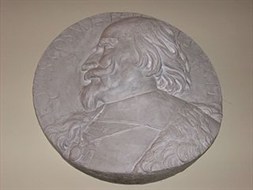Naples and early works
 Cosimo Fanzago (photo) was born in 1591 in Clusone, in the province of Bergamo, a descendant of a family that had a long tradition in bronze sculpture. He moved to Naples in 1608, becoming one of the leading artists of his time in the Spanish viceroyalty, helping to shape the face of the Baroque city. In the early years of his activity, Fanzago worked in partnership with the Florentine Angelo Landi, the father of his wife Felicia, mainly dealing with liturgical furniture and sculptures. His early sculptures, however, display a style which was not yet autonomous, influenced by the Tuscan Mannerism which was predominant in the production of early seventeenth century Neapolitan sculpture. Among them we can mention the coats of arms of the Count of Lemos (1615-1616) for the building of the university and now preserved in the Museo di San Martino, the bust of Michele Gentile (1616-1621) in Barletta Cathedral, Saint Ignatius in the cemetery of Catanzaro (1616), the memoria of Cardinal O. Acquaviva d’Aragona (1617-19) in the sacristy of the Church of Pio Monte della pietà (Pious Mount of Piety) and the half-length bust and the statue of Saint Ambrose (1618), both stored in Borrello chapel of the Gesù Nuovo Church. The bust of Girolamo Flerio, executed in 1620 and now preserved in the church of Saint Mary of Constantinople, already evinces greater autonomy and highlights the considerable talents of psychological penetration of the artist. Between 1619 and 1624 Fanzago also provided the overall design and models of statues that decorate the ciborium in polychrome marble for the Church of San Patrizia, now in the Museum of Capodimonte.
Cosimo Fanzago (photo) was born in 1591 in Clusone, in the province of Bergamo, a descendant of a family that had a long tradition in bronze sculpture. He moved to Naples in 1608, becoming one of the leading artists of his time in the Spanish viceroyalty, helping to shape the face of the Baroque city. In the early years of his activity, Fanzago worked in partnership with the Florentine Angelo Landi, the father of his wife Felicia, mainly dealing with liturgical furniture and sculptures. His early sculptures, however, display a style which was not yet autonomous, influenced by the Tuscan Mannerism which was predominant in the production of early seventeenth century Neapolitan sculpture. Among them we can mention the coats of arms of the Count of Lemos (1615-1616) for the building of the university and now preserved in the Museo di San Martino, the bust of Michele Gentile (1616-1621) in Barletta Cathedral, Saint Ignatius in the cemetery of Catanzaro (1616), the memoria of Cardinal O. Acquaviva d’Aragona (1617-19) in the sacristy of the Church of Pio Monte della pietà (Pious Mount of Piety) and the half-length bust and the statue of Saint Ambrose (1618), both stored in Borrello chapel of the Gesù Nuovo Church. The bust of Girolamo Flerio, executed in 1620 and now preserved in the church of Saint Mary of Constantinople, already evinces greater autonomy and highlights the considerable talents of psychological penetration of the artist. Between 1619 and 1624 Fanzago also provided the overall design and models of statues that decorate the ciborium in polychrome marble for the Church of San Patrizia, now in the Museum of Capodimonte.
